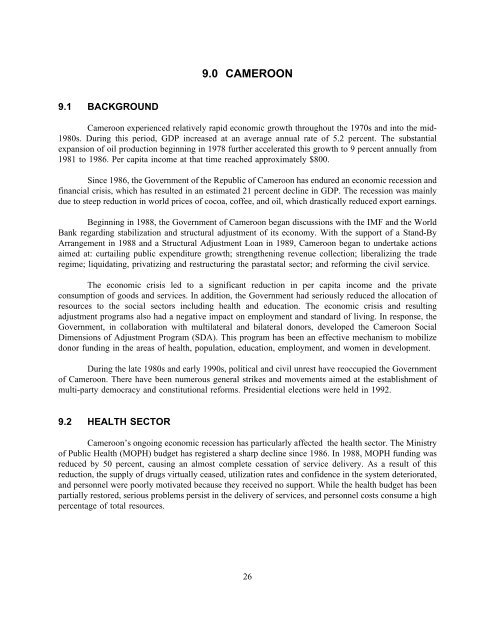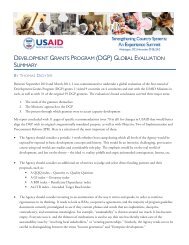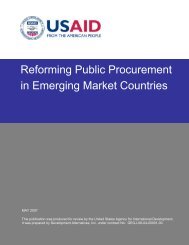Study on USAID Non-Project Assistance Programs in
Study on USAID Non-Project Assistance Programs in
Study on USAID Non-Project Assistance Programs in
You also want an ePaper? Increase the reach of your titles
YUMPU automatically turns print PDFs into web optimized ePapers that Google loves.
9.0 CAMEROON9.1 BACKGROUNDCamero<strong>on</strong> experienced relatively rapid ec<strong>on</strong>omic growth throughout the 1970s and <strong>in</strong>to the mid-1980s. Dur<strong>in</strong>g this period, GDP <strong>in</strong>creased at an average annual rate of 5.2 percent. The substantialexpansi<strong>on</strong> of oil producti<strong>on</strong> beg<strong>in</strong>n<strong>in</strong>g <strong>in</strong> 1978 further accelerated this growth to 9 percent annually from1981 to 1986. Per capita <strong>in</strong>come at that time reached approximately $800.S<strong>in</strong>ce 1986, the Government of the Republic of Camero<strong>on</strong> has endured an ec<strong>on</strong>omic recessi<strong>on</strong> andf<strong>in</strong>ancial crisis, which has resulted <strong>in</strong> an estimated 21 percent decl<strong>in</strong>e <strong>in</strong> GDP. The recessi<strong>on</strong> was ma<strong>in</strong>lydue to steep reducti<strong>on</strong> <strong>in</strong> world prices of cocoa, coffee, and oil, which drastically reduced export earn<strong>in</strong>gs.Beg<strong>in</strong>n<strong>in</strong>g <strong>in</strong> 1988, the Government of Camero<strong>on</strong> began discussi<strong>on</strong>s with the IMF and the WorldBank regard<strong>in</strong>g stabilizati<strong>on</strong> and structural adjustment of its ec<strong>on</strong>omy. With the support of a Stand-ByArrangement <strong>in</strong> 1988 and a Structural Adjustment Loan <strong>in</strong> 1989, Camero<strong>on</strong> began to undertake acti<strong>on</strong>saimed at: curtail<strong>in</strong>g public expenditure growth; strengthen<strong>in</strong>g revenue collecti<strong>on</strong>; liberaliz<strong>in</strong>g the traderegime; liquidat<strong>in</strong>g, privatiz<strong>in</strong>g and restructur<strong>in</strong>g the parastatal sector; and reform<strong>in</strong>g the civil service.The ec<strong>on</strong>omic crisis led to a significant reducti<strong>on</strong> <strong>in</strong> per capita <strong>in</strong>come and the privatec<strong>on</strong>sumpti<strong>on</strong> of goods and services. In additi<strong>on</strong>, the Government had seriously reduced the allocati<strong>on</strong> ofresources to the social sectors <strong>in</strong>clud<strong>in</strong>g health and educati<strong>on</strong>. The ec<strong>on</strong>omic crisis and result<strong>in</strong>gadjustment programs also had a negative impact <strong>on</strong> employment and standard of liv<strong>in</strong>g. In resp<strong>on</strong>se, theGovernment, <strong>in</strong> collaborati<strong>on</strong> with multilateral and bilateral d<strong>on</strong>ors, developed the Camero<strong>on</strong> SocialDimensi<strong>on</strong>s of Adjustment Program (SDA). This program has been an effective mechanism to mobilized<strong>on</strong>or fund<strong>in</strong>g <strong>in</strong> the areas of health, populati<strong>on</strong>, educati<strong>on</strong>, employment, and women <strong>in</strong> development.Dur<strong>in</strong>g the late 1980s and early 1990s, political and civil unrest have reoccupied the Governmentof Camero<strong>on</strong>. There have been numerous general strikes and movements aimed at the establishment ofmulti-party democracy and c<strong>on</strong>stituti<strong>on</strong>al reforms. Presidential electi<strong>on</strong>s were held <strong>in</strong> 1992.9.2 HEALTH SECTORCamero<strong>on</strong>’s <strong>on</strong>go<strong>in</strong>g ec<strong>on</strong>omic recessi<strong>on</strong> has particularly affected the health sector. The M<strong>in</strong>istryof Public Health (MOPH) budget has registered a sharp decl<strong>in</strong>e s<strong>in</strong>ce 1986. In 1988, MOPH fund<strong>in</strong>g wasreduced by 50 percent, caus<strong>in</strong>g an almost complete cessati<strong>on</strong> of service delivery. As a result of thisreducti<strong>on</strong>, the supply of drugs virtually ceased, utilizati<strong>on</strong> rates and c<strong>on</strong>fidence <strong>in</strong> the system deteriorated,and pers<strong>on</strong>nel were poorly motivated because they received no support. While the health budget has beenpartially restored, serious problems persist <strong>in</strong> the delivery of services, and pers<strong>on</strong>nel costs c<strong>on</strong>sume a highpercentage of total resources.26







